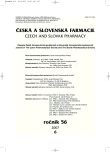Flavonoid accumulation in Scutellaria baicalensis Georgii in vitro cultures upon treatment with sodium cinnamate
Nárůst obsahu flavonoidů v in vitro kulturách Scutellaria baicalensis Georgii po přidání skořičnanu sodného
Za jednu z možností, jak získávat sekundární metabolity rostlin, je považována produkce pomocí in vitro kultur. V těchto kulturách však bývá biosyntéza těchto látek často nedostatečná, nebo je potlačena úplně. Ke zvýšení produkce sekundárních metabolitů se používá řada metod, jako jsou například optimalizace kultivačního média, elicitace, genetická manipulace, a také přidávání prekurzorů do média. V této studii byl zkoumán vliv pěti prekurzorů na množství baicalinu a baicaleinu v suspenzních a kalusových kulturách šišáku bajkalského (Scutellaria baicalensis Georgii). Výsledky ukazují, že zejména skořican sodný v koncentraci 5 mg.l⁻¹ a kyselina skořicová (1 mg.l⁻¹) významně zvyšují obsah obou flavonoidů. Přídavek L-fenylalaninu, kyseliny malonové a malonanu sodného nemělo vliv na množství flavonoidů ani na růst kultur.
Klíčová slova:
Scutellaria – šišák – prekurzor – skořican sodný – kyselina skořicová – in vitro kultury
Authors:
J. Martin; J. Dušek
Authors‘ workplace:
Charles University in Prague, Faculty of Pharmacy in Hradec Králové, Department
of Pharmacognosy
Published in:
Čes. slov. Farm., 2007; 56, 280-283
Category:
Original Articles
Overview
The production of secondary metabolites by plant cell cultures has been suggested as a feasible technology that attracted considerable industrial and academic interest in the past three decades. However, many secondary pathways are not well expressed in plant cell cultures. Optimization of culture medium, elicitation, genetic engineering and the supply of biosynthetic precursors are among the strategies adopted to increase secondary metabolite production in vitro. In this study, the effects of five potential biosynthetic precursors on the production of baicalin and baicalein in Scutellaria baicalensis Georgii suspension and callus cultures were measured. The results of this work show that flavonoid biosynthesis was most stimulated by the addition of sodium cinnamate in the concentration of 5 mg.l⁻¹ and by cinnamic acid (1 mg.l⁻¹). Feeding with L-phenylalanine, malonic acid and sodium malonate did not induce changes in the amounts of flavonoids, and the biomass production was not affected.
Key words:
Scutellaria – skullcap – precursor – sodium cinnamate – cinnamic acid – in vitro cultures
Labels
Pharmacy Clinical pharmacologyArticle was published in
Czech and Slovak Pharmacy

2007 Issue 6
Most read in this issue
- Experience with ciclesonide in patients with mild persistent bronchial asthma
- Physiology and pharmacology of hyaluronic acid
- Oxycellulose – a cellulose derivative with a potential to become an active pharmaceutical substance as well as an auxiliary substance
- A study of the properties of tablets from coprocessed dry binders composed of α-lactose monohydrate and different types of cellulose
